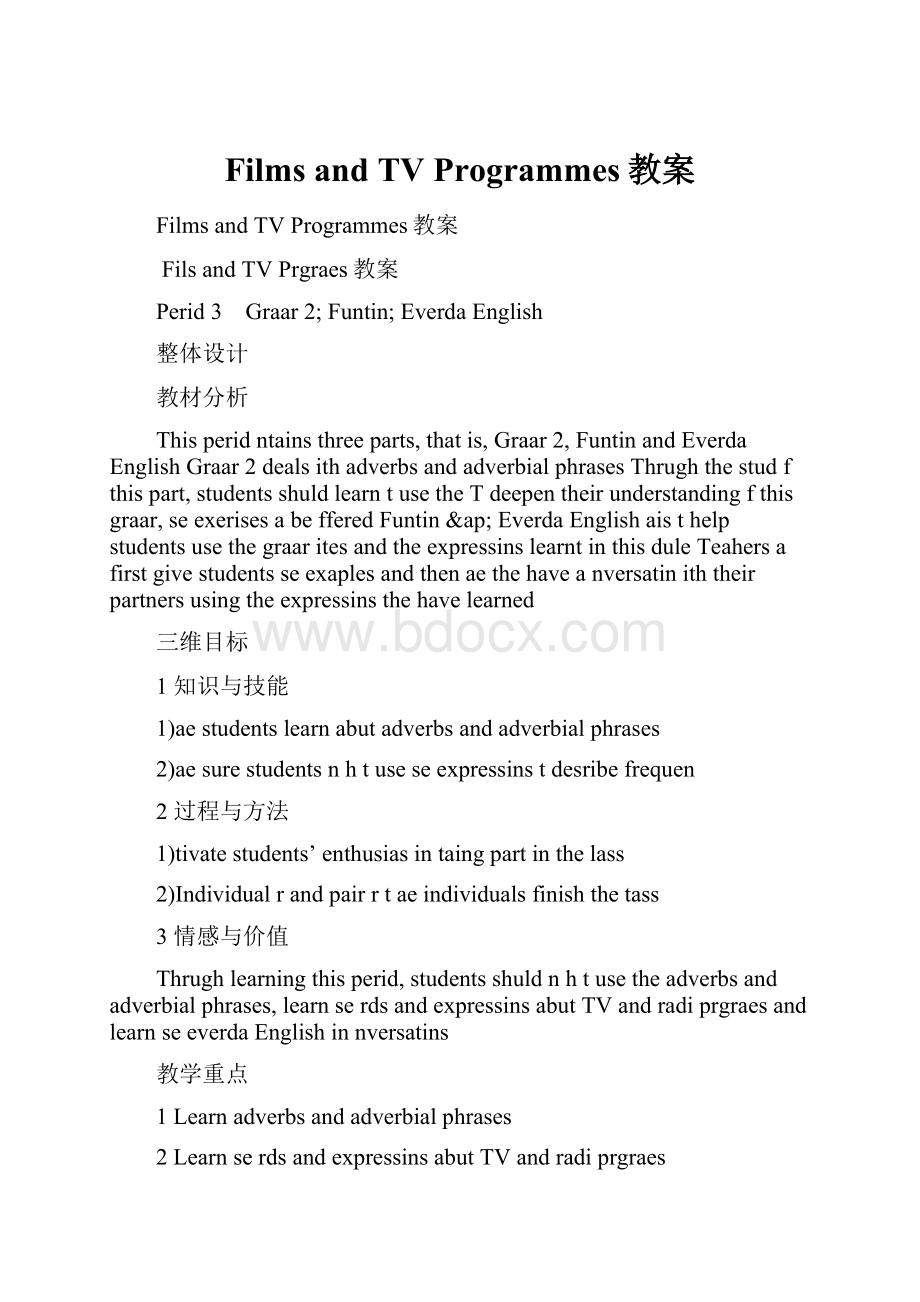Films and TV Programmes教案.docx
《Films and TV Programmes教案.docx》由会员分享,可在线阅读,更多相关《Films and TV Programmes教案.docx(11页珍藏版)》请在冰豆网上搜索。

FilmsandTVProgrammes教案
FilmsandTVProgrammes教案
FilsandTVPrgraes教案
Perid3 Graar2;Funtin;EverdaEnglish
整体设计
教材分析
Thisperidntainsthreeparts,thatis,Graar2,FuntinandEverdaEnglishGraar2dealsithadverbsandadverbialphrasesThrughthestudfthispart,studentsshuldlearntusetheTdeepentheirunderstandingfthisgraar,seexerisesabefferedFuntin≈EverdaEnglishaisthelpstudentsusethegraaritesandtheexpressinslearntinthisduleTeahersafirstgivestudentsseexaplesandthenaethehaveanversatiniththeirpartnersusingtheexpressinsthehavelearned
三维目标
1知识与技能
1)aestudentslearnabutadverbsandadverbialphrases
2)aesurestudentsnhtuseseexpressinstdesribefrequen
2过程与方法
1)tivatestudents’enthusiasintaingpartinthelass
2)Individualrandpairrtaeindividualsfinishthetass
3情感与价值
Thrughlearningthisperid,studentsshuldnhtusetheadverbsandadverbialphrases,learnserdsandexpressinsabutTVandradiprgraesandlearnseeverdaEnglishinnversatins
教学重点
1Learnadverbsandadverbialphrases
2LearnserdsandexpressinsabutTVandradiprgraes
3TalabutTVprgraes
教学难点
1Usetheadverbsandadverbialphrasesprperl
2Gettheeaningsftherdsthrughdefinitins
3HttalabutTVprgraes
教学过程
→Step1Revisin
1Greetthehlelassasusual
2heuptheirher
→Step2Graar2:
Adverbsandadverbialphrases
1Readthesentenesandanserthequestins
Shthefllingnthesreenaesuretheunderstandeverthingandthenletthestudentsanserthequestinsindividuall
Aealasathtellintherningaseeaturbreafastintheithen
BIathfilsallthetieattheeeend
Isaabrilliantneesterda
DEverneinitatssbrilliantl
Questins:
1Isbrilliantanadetive(desribinganun)ranadverb(tellinguabutaverb)?
2Hduaeadverbsfradetives?
anuaeanadverbfrtherdqui?
3anufindrdsandphrasesthatansersthesequestins:
hen?
here?
H?
Suggestedansers:
1adetivedesribing“ne”(prnunfr“fil”)
2ufrequentladd-lttheendftheadetive,egquil
3hen?
:
aseeaturbreafast;intherning;allthetie;attheeeend;esterda
here?
:
intheithen
H?
:
brilliantl
2DAtivit2inthetextbnpage6
Suggestedansers:
1h?
(happil) here?
(inhisbedr) hen?
(everevening)
2h?
(arefull) hen?
(esterda)
3h?
(quietl) here?
(atthebusstp) hen?
(eahda)
3Tellstudentsserulesfadverbs’rderinthesentenes
Givestudentsseexaplesentenesandhavetheunderstandthelatinfadverbs
1)Ihardleverheardhisinging
2)uustalaseepthisinind
3)HeasbrninBeiingintheear1980
4)Hedesn’tquiteagreeithu
)Shedeseverthingarefull
Thrughanalzingsentenes,thestudentsanrevietheprperpsitinftheadverbsinthesentenesandandbetterhenaingsentenes
4Dtheexerisesinativit3Puttherdsinthesentenesbelintherretrder
Letstudentsanserthequestinsindividuallandllettheansersinlass
Suggestedansers:
1)Ispentaltfneatthesuperaretesterda
2)Theanaledquildnthestreet
3)uplaedellesterda
4)Thestudentshaveredhardtda
)Thinarefullbefreutalther
6)Thebseretalingludlintherridresterda
7)Thedrvettheairprtearlintherning
→Step3Funtin:
Talingabuthftenudthings
1Brainstring
AsstudentstspeautthestTVrradiprgraesthe’veevern
TheEasterTies Enis30inutes EnglishNesServie TVTheatre TVNes Anialrld Arsstheuntr usiHtLine FreignLightusi
TV≈FilSngs Sundfusi
2Ativit1:
aththetpesfTVandradiprgraesiththedefinitins
Shthefllingnthesreen
hatsh edprgrae quizsh sap(pera) sprtsprgrae thenes TV/radidraa
Aaprgraeinhihfauspepletalabuttheselvesandtheirr
Baprgraeinhihpeplehavetanserquestinsrretl
aprgraethattellsuabutreentevents
Daninterestingandexitingstrithatrsplaingdifferentparts,rittenfrTVrradi
Eaprgraeabuttherdinarlivesfthesaegrupfpeplethatisshnnertieaee
Suggestedansers:
Ahatsh Bquizsh thenes DTV/radish Esappera
3Ativit2:
Usetheadverbsandadverbialphrasestsahftenuanaththedifferenttpesfprgraesinativit1Pleasepaattentinttherretpsitinfadverbs
Theadverbsandadverbialphrasesffrequen:
seld rarel asinall evernandthen ften seties neaee everda (fur)tiesaee frtiettie evertdas tieanth
Suggestedexaples:
Irarelathsapperas
Iaththenesabutfurtiesaee
Iseefilsneanth
→Step4EverdaEnglish
pletethesentenesusingtheseexpressins
Readthrughtheexpressinsinthebxhilethestudentslistenandfll
Readtheagainandhavestudentsrepeattheafterteahershrallandindividuall
hethestressinabslutel
Asthetpletethesentenesindividuall,thenhetheiransersithapartner
llettheansersfrthehlelassaspletesentenes
ashrtspaeftie abslutel gdfru thebx thethingis hat’sn
1Inlath_________nSundas
2Hefinisheditin_________
3A:
_________TVthisevening?
B:
There’sareallgddraa
4A:
In!
B:
_________!
There’ssethingIneedttellu,sir_________,Ihaven’tdneher
6A:
Duenathingvies?
B:
_________!
Suggestedansers:
1thebx 2ashrtspaeftie 3hat’sn 4Gdfru
Thethingis 6Abslutel
→StepSuarandHer
TeaherssuariehathasbeenlearnedinthisperidThisperidstudentsainllearnedtheadverbsandadverbialphrasesThrughthestudfthisperid,thearesuretgainthegistfthisgraarBesides,thehavelearnedreabutTVandradiprgraesandpratieusethegraariteslearnedinthisduleAttheendfthisperid,seherisassigned
Her:
1erizethenerds
2Dexerisentherb
板书设计
dule6 FilsandTVPrgraes
Perid3
Theadverbsandadverbialphrasesffrequen:
seld rarel asinall evernandthen ften seties
neaee everda (fur)tiesaee frtiettie
evertdas tieanth
活动与探究
henlearnthesendlanguage,itisalsiprtanttparethesendlanguagetthetherlanguage
备资料
Abuttherdrder
1了解语序的重要性
任何一种语言的句子成分都是按照该语言的使用习惯去排列的,否则就会造成语意或语法错误,或至少不地道。
TheartandliteratureftheanientGreeefasinatedtheturists和TheturistserefasinatedbtheartandliteratureftheanientGreee这两个句子在语意和语法上都没有问题,但感觉第二个句子比第一个句子更自然,之所以如此,就在于第二句在语序的排列上更加合理。
按照习惯,语序是相对固定的,但因表达的需要又有灵活性,语序排列要受到意图、语意中心、强调重点、语言环境和修辞效果等多种因素的制约和影响。
了解和掌握英语语序的特点可以提高我们驾驭语言的能力,对实现双语等值交换,提高语言教学水平具有非常重要的现实意义。
2英语语序
英语在其长期演变、发展中已经形成相对固定的语序,基本特征就是“主+谓”结构。
交际中传递的信息片段通常由已知信息(GivenInfratin)和新信息(NeInfratin)组成,信息的出发点通常由主语表示,新信息是传递的重点,通常由谓语表示。
英语语序主要分为两类:
即无标记语序(unaredrdrder)和有标记语序(aredrdrder)。
无标记语序就是我们常见的自然语序或称基本语序(nralrder),有标记语序则“违反常规”,在无标记语序基础之上转换而。
转换的主要方式有:
前置(Frnting)和后置(Pstpneent)。
3英语语序分类
语法上通常将英语语序分成两类:
无标记语序和有标记语序。
英语当中大量存在的是无标记语序,也就是我们常说的自然语序或基本语序。
例如:
Idisliesuhpepleandbehavir而如果句子语序变为:
SuhpepleandbehavirIdislie语法上就认为是有标记的。
在此主要讲一下无标记语序。
无标记语序
英语句子中的各种成分,位置都是相对固定的,一般不能任意变化。
它的语法主语就是无标记主题,英语五种基本句型中的成分就相对固定。
S+V:
Thesunisshining
S+V+:
Heasveranxius
S+V+:
Sheillneverfrgivee!
S+V++:
TheguideshedtheturiststhesightsfLndn
S+V++:
ststudentsfundherhelpful
注意双宾语结构的安排:
带介词的间接宾语通常放置于直接宾语之后,但直接宾语字数较多,结构复杂时,带介词的间接宾语要提前,句子重心才平衡。
例如:
TheguidedesribedtheturistsLndn’ssenispts
TheguidedesribedLndn’ssenisptsttheturists
ThePrieinisterexplainedttheHusethevariushthepeaetalshadfailed
状语的位置
状语是英语句子中很活跃并且也是很复杂的一个成分,任何起副词作用的单词、词组或分句都是状语,可以出现在句中的多个位置。
语法上一般把状语分成三大类:
修饰性状语、评注性状语和连接性状语。
最为常见和最为重要的是修饰性状语。
修饰性状语主要用修饰谓语或谓语动词。
修饰性状语按其内容可分为时间、地点、方式、目的、程度、原因、结果、条、让步等状语。
英语句子的语序一般是:
主语+谓语+宾语+修饰性状语,一般不在谓语动词和宾语之间插进状语。
可以说:
Ieturparentsesterda或esterdaIeturparents但不可以说:
Ietesterdaurparents
(1)修饰性状语在句子的位置一般说是在句末,但根据表达的需要也可在句首或句中。
例如:
Theheedtheirequipentarefull(adverbialfanner)
Aseuritguardasstandingattheashpintahine(plaeadverbial)
TheBattleftheBnetplaein1690(tieadverbial)
焦点副词(fusingadverb)都置于句中。
例如:
Iaspartiularlipressedbherdaningandsinging
BbnlathedEnglishpreiershipnSundas
(2)修饰性状语置于句首或放在主语之前时,一般有强调作用。
在叙事体中,状语置于句首更能引起读者的注意。
例如:
Atten’lesterdaIentdnfrdinneritha
Befrehisther,Tisalasagdb
Frantpfinanialexeutives,eventhseatpaniessuhasGE,hihntinuesttppllsfthestrespetedrpratinsintherld,theprbleisthatthearetisinflitingthepunishentbefreanriehasbeenunveredThatisheapingevenrepressurenthefinanefuntin
程度副词作状语时,一般置于句首。
例如:
Igreatlenedringithsuhenergetigus
(*GreatlIenedringithsuhenergetigus)
(3)修饰性状语可以置于主语和主要动词之间,也具有一定的强调作用,但程度不如置于句首强烈。
单个副词置于主语和主要动词之间是很常见的。
例如:
Iftengsiingandhuntinginthesuer
Theaptainindlinvitedusntthebridge
常置于主要动词之前的修饰性状语有:
A绝大多数不定频度副词:
alas,usuall,seld,ntinuusl,ever,repeatedl,seties,nrall,never,ften,nstantl,frequentl,regularl,rarel,ntinuall等。
确定频度副词一般不这样使用,往往置于句末。
例如:
NerTiesisdelivereddail
B某些不定时间副词:
again,first,sine,finall,ust,alread,reentl,last等。
确定时间副词不放在句中,一般置于句首或句末。
例如:
ThedaaftertrreareleavingfrBeiing
(*earetrrleavingfrBeiing)
某些程度副词,特别是起强调作用的程度副词:
alst,altgether,abslutel,badl,pletel,deepl,entirel,fairl等。
D前置修饰动词的焦点副词(焦点副词指出所讲内容中最有关联的事项,如做某事的主要理由或某事物具有的主要特质):
even,erel,nl,sipl,ust,reall,partiularl等。
(4)两个或两个以上不同性质的状语连续使用时
A通常的排列顺序为:
方式状语—地点状语—时间状语。
例如:
Theplanetffnisil(anner)intthedars(plae)ustbefredan(tie)
以上顺序并不是固定不变的,受数量、长度以及强调重点等因素的影响,会有变化。
一般避免把字数较多的状语排列在字数较少的状语之前。
为使结构平衡、节奏流畅或上下的衔接自然,常将时间状语或地点状语等移至句首。
例如:
utersstreautfthestatineverrninglieanarfantsntheve
Agrupftrapssettledlasteentheastelandbtheshefatr
Thisrningaanasalingquilbehindenheratr
Thehlerningheasringnhisspeehintheffie
B有方式副词又有dn,ut,he等方向副词时,方向副词先于方式副词。
例如:
Healedhequillastnight
Treaheddnsll
时间状语一般位于方向状语、方式状语、位置状语之后,但频度状语在句子中可有两个位置:
Sheeatslunhquileverdaatnn
Sheeatsquillunhatnneverda
D原因状语和目的状语倾向于出现在其